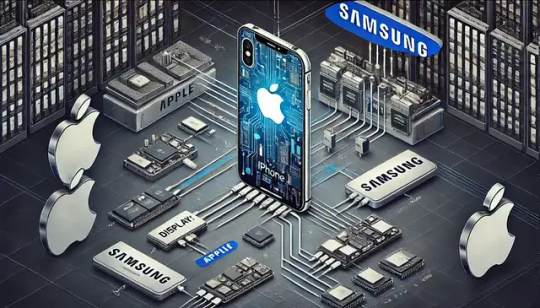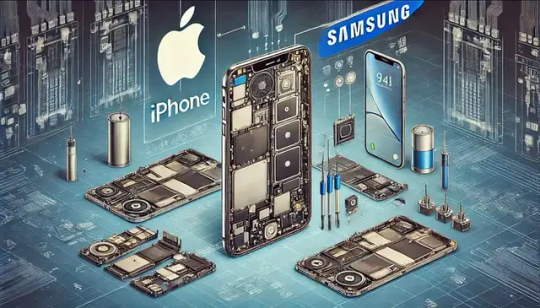#Power Electronics Market Share
Explore tagged Tumblr posts
Text
Power Electronics Market Size, Share And Trends Analysis Report
The global power electronics market size is expected to reach USD 53.66 billion by 2030, registering to grow at a CAGR of 5.2% from 2024 to 2030 according to a new report by Grand View Research, Inc. Increased focus on the usage of renewable energy sources has been one of the major factors driving the market. In addition, the development of power infrastructure, coupled with the increasing demand for battery-powered portable devices, has led to the increased adoption of power electronic devices and products across various industry verticals such as power, automotive, communication, aerospace & defense, consumer electronics, and other sectors.
Power electronic devices use switching electronic circuits to regulate the flow of energy. They are also used in the alteration of electric power, which is usually performed by semiconductor devices such as diodes, transistors, and thyristors. Power electronic devices are useful in connecting renewable energy resources with power grids and transportation of energy. They have applications in electric trains, motor drives, and lighting equipment and play a key role by enabling heat sinking and soft starting of the motors.
The power electronics market is extensively consolidated, in terms of applications and materials that are used to produce power electronic devices. The advancements and exhaustive research & development activities in the power devices have enabled the evolution of power electronics. The market possesses significant potential for growth and is dynamic and adaptive in nature. A few highlighting features of the power electronic devices are durability against coarse environmental conditions, extended life (suitable for rugged industrial applications), and better efficiency & reliability.
The power electronics industry has been undergoing continuous developments and upgrades, since its emergence. Several factors, such as the rapid inception of renewable energy sources and rising adoption of electric vehicles & radio communication, are influencing the market growth. The adoption of power electronic devices in healthcare systems & instruments and the automotive industry is expected to drive the market over the forecast period.
Gather more insights about the market drivers, restrains and growth of the Power Electronics Market
Power Electronics Market Report Highlights
• The global power electronics market was valued at USD 38.12 billion in 2023 and is expected to grow at a CAGR of 5.2% from 2024 to 2030
• The silicon (Si) segment held the largest market revenue share of 88.9% in 2023. The demand for silicon in the power electronics market is increasing due to its essential properties that meet the growing needs of high-efficiency and high-performance applications. Silicon's ability to withstand high temperatures and voltages and its superior electrical conductivity and thermal stability make it suitable for power devices like transistors, diodes, and integrated circuits
• IC segment dominated the market in 2023. The increasing utilization of smart systems and electric vehicles due to technological progress boosts the need for power electronics. These gadgets depend on effective power transformation and management systems supplied by ICs.
• Automotive segment is projected to grow at the fastest CAGR over the forecast period. The shift towards electric vehicles (EVs) and hybrid vehicles is a primary driver, as these vehicles rely heavily on power electronics for efficient energy management, battery charging, and motor control.
Power Electronics Market Segmentation
Grand View Research has segmented the global power electronics market based on material, device, application, and region:
Power Electronics Material Outlook (Revenue, USD Million, 2018 - 2030)
• Silicon (Si)
• Sapphire
• Silicon Carbide (SiC)
• Gallium Nitride (GaN)
• Others
Power Electronics Device Outlook (Revenue, USD Million, 2018 - 2030)
• Discrete
• Module
• IC
Power Electronics Application Outlook (Revenue, USD Million, 2018 - 2030)
• ICT
• Consumer Electronics
• Power
• Industrial
• Automotive
• Aerospace & Defense
• Others
Power Electronics Regional Outlook (Revenue, USD Million, 2018 - 2030)
• North America
o U. S.
o Canada
o Mexico
• Europe
o UK
o Germany
o France
• Asia Pacific
o Japan
o China
o India
o Australia
o South Korea
• Latin America
o Brazil
• Middle East and Africa (MEA)
o UAE
o Saudi Arabia
o South Africa
Order a free sample PDF of the Power Electronics Market Intelligence Study, published by Grand View Research.
#Power Electronics Market#Power Electronics Market Size#Power Electronics Market Share#Power Electronics Market Analysis#Power Electronics Market Growth
0 notes
Text
The Digital Power Electronics Market size is estimated to reach US$42.8 billion by 2027, growing at a CAGR of 5.1% from 2022 to 2027. The emphasis on renewable energy in power generation, the rising acceptance of automation and industry 4.0 is fueling the growth of the Digital Power Electronics Industry. Additionally, the growing demand for consumer electronics and electric vehicles is also propelling the demand for digital power electronics, thereby expanding the market size. Different substrate materials such as Gallium Nitride, Silicon Carbide, Silicon and Sapphire are being used in making digital power IP cores and microcontrollers which effectively increase the functionality of integrated circuits, thereby making digital power electronics components more lucrative
0 notes
Text
The power electronics market is projected to grow from USD 46.2 billion in 2023 to USD 61.0 billion by 2028; it is expected to grow at a CAGR of 5.7% from 2023 to 2028. Power electronics involves using solid-state electronics to efficiently convert and control electric power from one form to another.
0 notes
Text





🎄💾🗓️ Day 7: Retrocomputing Advent Calendar - Altair 8800🎄💾🗓️
The Altair 8800 was one of the first commercially successful personal computers, introduced in 1975 by MITS, and also one of the most memorable devices in computing history. Powered by the Intel 8080 CPU, an 8-bit processor running at 2 MHz, and initially came with 256 bytes of RAM, expandable via its S-100 bus architecture. Users would mainly interact with the Altair through its front panel-mounted toggle switches for input and LEDs for output.
The Altair 8800 was popularized through a Popular Electronics magazine article, as a kit for hobbyists to build.
It was inexpensive and could be expanded, creating a following of enthusiasts that launched the personal computer market. Specifically, it motivated software development, such as Microsoft's first product, Altair BASIC.
The Altair moved from hobbyist kits to consumer-ready personal computers because of its modular design, reliance on the S-100 bus that eventually became an industry standard, and the rise of user groups like the Homebrew Computer Club.
Many of ya'll out there mentioned the Altair 8800, be sure to share your stories! And check out more history of the Altair on its Wikipedia page -
along with the National Museum of American History - Behring center -
Have first computer memories? Post’em up in the comments, or post yours on socialz’ and tag them #firstcomputer #retrocomputing – See you back here tomorrow!
#retrocomputing#altair8800#firstcomputer#electronics#vintagecomputing#computinghistory#8080processor#s100bus#microsoftbasic#homebrewcomputerclub#1975tech#personalcomputers#computerkits#ledswitches#technostalgia#oldschooltech#intel8080#computerscience#techenthusiasts#diycomputing#earlycomputers#computermemory#vintageelectronics#hobbycomputing#popularelectronics#techhistory#innovation#computermilestones#geekculture
45 notes
·
View notes
Text
Gigabash character overview: Woolley
It’s pretty common for media to have at least one adorable and marketable character, and Passion Republic Games have one for Gigabash. Being one of the four initial kaiju developed, Woolley was made to be cute and likable. He even had a promotional plush of his S-class form sold in the lead up to the game’s release!

Woolley is a slightly more defensive character with some quick movement options, a counterattack move, and two attacks that are impossible to block and require good timing to stop. He’s got a high skill ceiling and pulling off extensive combos can be tricky. But like with every character in Gigabash’s roster, he’s deadly in the hands of someone who knows what they’re doing.
Design
PRG took awhile to get a good design to settle on with Woolley, as they wanted him to be cute and likable all around and have a simple silhouette that was easily recognizable. Like Gorogong and Pipijuras, he went through multiple design revisions.


While there’s no direct statement on if any particular kaiju inspired Woolley’s design, he does bear a passing resemblance to another popular Tsuburaya icon: Booska.

Lore
Woolley is just one member of a species of kaiju known as the Yetis, peaceful kaiju who live in herds where they sleep and play all day and subsist entirely on Giga Energy. The reports on his character file actually give us insight into the evolution of his species, and how kaiju might evolve in the world of Gigabash.
Yetis are descendants of a small mammal with thick fur that migrated to the Himalayas sometime in the Pleistocene Epoch. Here they also used local hot springs to help stay warm, but these hot springs were connected to underground veins of Giga Energy. As they were gradually exposed to the substance, they slowly became larger and larger over subsequent generations and came to rely less and less on food for energy. In only a few million years they became 120 ton titans. They remained there until near modern day, and for the local humans it was common practice to go and collect shed Yeti fur to be used in the creation of coats.
At some point though, these Giga Energy veins ran dry, and this forced them to search for a new home. At least some of them migrated to a remote place in Siberia surrounded by mountains that has been dubbed the Yeti Sanctuary, and is rich with hot springs and Giga Energy. It even has an entrance to the hollow earth! The same one Pipijuras uses in his story mode too.
Woolley’s story mode revolves around him getting lost and trying to get home. One day he sees planes flying overhead and follows them out of curiosity, but gets lost in the process.

In his effort to go home he actually goes the opposite direction of where he came and gets increasingly distracted on his adventure, ping ponging across the world and interrupting the events of Pipijuras and Gorogong’s story modes.

It’s during this story mode we learn about a somewhat important location and information about the Yetis, another kaiju we’ll eventually get to, and kaiju as a whole in the world of Gigabash.
The area, which is one of the maps, is the Power Station, a section of Area 51 which seeks to figure out how to properly harness Giga Energy. As you’re aware, humanity has been trying to harness Giga Energy, but they’re having difficulties. Like with almost all of humanity’s power sources, in order to get electricity out of it you need to figure out a way to get it to turn a turbine that can spin a magnet around some electrical wires. This gets electrons flowing and thus generates electricity, and this is the basic principle of creating usable electricity. Apparently it’s hard to get Giga Energy to do this safely, although what part of the process is difficult to do with Giga Energy is never said. Only Otama Tec has figured out how to get this to work with the creation of their Gigatron Reactor, and they’re not keen to share their discoveries for reasons we’ll get to in the next overview. So the Global Titan Defense Initiative, being the dickwads they are, did a little corporate espionage and stole the blueprints of an earlier more theoretical version of the Gigatron Reactor and created the Power Station to test it out and improve it. It uses Giga Crystals (again, we’ll get to it) as the main source of Giga Energy, but kaiju can apparently be used as well since in his story mode Woolley gets captured and chained up to meet this fate. However, the Power Station is riddled with issues in no small part due to the sheer power of Giga Energy. It’s so dangerous that the GTDI makes any employees working there unsubscribe from their life insurance because of course they would do that.

As Woolley travels around the world, he meets entirely new herds of Yetis on his travels in every major location he stops at. These Yetis all have different colorations than Woolley and his herd, and are described as subspecies. It’s pretty likely that when the Yetis migrated from the Himalayas, the population split up in their search for sources of Giga Energy, and these different populations diverged from each other. They aren’t entirely isolated though as a few are aware of each other’s existence and point Woolley in each other’s direction, and it seems that Yetis as a whole have a shared language.
This brings us to something that’s never really explicitly stated but is shown to us and is obvious in hindsight; the kaiju in the world of Gigabash are sapient. The game is a party fighting game so obviously they would have to be smart in universe in order to have battle strategies and know how to use city infrastructure as tools and weapons as the player demands, but it’s one of those things where you realize it and go “Oh, yeah that makes a lot of sense… why didn’t I realize it until now?”. The Yetis in particular have even learned how to use fire, although they use burning vehicles as fuel instead of dry wood.

This shot also shows that Yetis can go bald. Like and reblog this post to slap the elder yeti’s bald head.
Woolley’s story concludes with him staying focused and retracting his steps (which gives us a lot of fun pictures) and eventually finding his way home.

There is of course one last fight, but it turns out that the other Yetis he met decided to follow him, and end up helping in defending his home. Afterwards they end up integrating with the Siberian herd quite well! Even though Woolley spent his story trying to get back to his family, it’s sweet to know that his efforts gave him an even bigger one.

All in all, Woolley is a great character and is a fun and adorable addition to Gigabash’s roster, and his story mode is sweet.
Also I don’t really know where else to put this but lore tidbit: in the Gigabash universe it’s implied the Soviet Union fell but Russia is still a communist country unlike the capitalist IRL Russia. They’re a dictatorship like IRL Russia though.
19 notes
·
View notes
Text
Best and Cheapest SMM Panel Services - MySMM.co
SMM (Social Media Marketing) stands now not only as the option for marketing but as one of the essential tools for promoting economic actors or services in the digital environment. Certainly, the popularity of such giants like Facebook, Instagram and YouTube show that having a powerful presence on the internet is not only good; it is crucial. But how exactly can social media marketing transform your online presence? Let’s explore SMM Panel in detail while focusing on tools and services like the Instagram SMM Panel, YouTube SMM Panel and Facebook SMM Panel.
The Power of Social Media Marketing - MySMM
Social media accounts for billions of users across the world making it the best platform for engaging, branding and selling. However, the possibilities of such platforms are actually hidden in a specific approach. Social media marketing also assists in increasing the media visibility, interaction and consequently traffic on the firm’s website.
MySMM.co offer best & cheapest SMM panel in worldwide. You can buy likes, share, subscribe, comments, followers and more for Instagram, Facebook, Twitter, YouTube.
Be it an entrepreneur, holding a small business or being a content developer, using the proper tools like an SMM Reseller Panel or the Best SMM Panel will always act as a time and cost savior to the maximum level.
Key Benefits of Social Media Marketing
1. Enhanced Brand Visibility
Social media forums are an electronic bulletin to your business or company. By using the services like Cheapest SMM Panel you can promote your posts, attract the attention of users and customers at a significantly lower cost of classic advertising.
2. Increased Engagement
Interesting and timely content will definitely spark a number of likes, sharing’s and comments, thus creating a following around your brand. I believe that promoting an account organically with the help of an Instagram SMM Panel can keep the page active and popular at the same time.
3. Cost-Effectiveness
SMM is not like the general methods of marketing since it provides outstanding returns on investment. The Best SMM Panel means that you don’t have to spend a lot of money to get seen by people.
4. Insights and Analytics
Many SMM services of current days like YouTube SMM Panel and Facebook SMM Panel have analytics that can track and show the ROI. These ones assist in refining your strategy in order to get the next level results.
5. Brand Authority
The maintenance of social media one of the important aspects of business is credibility. When customers observe engagement on the profile, this convinces them to trust your brand.
Tools That Elevate Social Media Marketing
· Best SMM Panel
When it comes to dealing with numerous accounts & campaigns available on social media platforms as a social media marketer the Best SMM Panel acts like a right hand. It saves time by eliminating repetitive tasks, gives performance feedback and guarantees efficiency of endeavors.
· SMM Reseller Panel
An SMM Reseller Panel is useful to anyone who seeks to engage in the business of being an SMM provider. With this tool you can control the client accounts, provide the results and even resale the SMM services.
· Cheapest SMM Panel
Marketing is capable of being modified based on your budget it should not in any way hider you’re marketing. The Cheapest SMM Panel helps organizations can get the best results at a local level without investing large amounts of money to be able to compete fairly.
· Instagram SMM Panel
Given the fact that Instagram is one of the most visually-oriented social networks, an Instagram SMM Panel will help to amplify your actions. Sprouting is good for gaining a following, increasing engagement and even for a specific purpose like promoting the use of stories or reels.
· YouTube SMM Panel
For video marketing YouTube is also very significant as is the second largest search engine in the world. A YouTube SMM Panel guarantees that the broadcasts you prepare get to the right people and get views, likes and subscriptions in the blink of an eye.
· Facebook SMM Panel
Facebook remains one of the most effective marketing tools with the wide users base and the opportunities for targeting. A Facebook SMM Panel is a great way of making these features more effective and ensure successful marketing campaigns.
Practical Strategies for Transforming Your Online Presence
1. Content is King
Make sure the content is always well-written and that you provide something which will interest your target audience. For instance, when using the Instagram SMM Panel or the YouTube SMM Panel, one can always promote material in a manner that shall be appealing to the audience.
2. Consistency Matters
There’s nothing more crucial than consistency: the more often one posts, the more often the content will appear on the audience’s feed. In the case of using the Best SMM Panel, posting tools are available to schedule your posts to go out as frequently as needed.
3. Engage With Your Audience
For engagement to work, it cannot be a one-sided affair. Thank for the comments, try to comment on other posts and make your audience to feel special. By engaging the services of a Facebook SMM Panel, organization-specified interactions may be automated while maintaining rich and individualized account experiences.
4. Use Analytics for Optimization
Get into the detail of the analytics we have for reach, impressions and engagement in order to optimize your approach. SMM services such as the YouTube SMM Panel offer information on what should be done and what should not be done.
5. Leverage Paid Promotions
While it is always helpful to have organic growth there is always the need to make a more direct hit with paid promotions. It goes without saying that services such as the Cheapest SMM Panel allow you to reach the right audience at the lowest prices.
MySmm.co can do wonders for you making you a brand or a social media influencer. The use of products like the Best SMM Panel, SMM Reseller Panel, Cheapest SMM Panel, Instagram SMM Panel, YouTube SMM Panel and Facebook SMM Panel place your efforts in the right direction and help increase your return on investment and results. No matter if you stand at the beginning of your transformation or need to evolve your planning to new levels these measures exemplify your commitment to a continued success in the digital domains.

3 notes
·
View notes
Text

On January 3, 2009, a quiet yet revolutionary moment unfolded—the mining of the Bitcoin Genesis Block. This "primordial block" marked the birth of the Bitcoin blockchain, and with it, the dawn of decentralized finance. The first block, mined by the enigmatic Satoshi Nakamoto, carried a reward of 50 bitcoins. At today’s rates, that’s roughly $4.8 million. Yet, back then, it symbolized more than monetary value—it embodied a vision for a peer-to-peer electronic cash system, outlined in Nakamoto’s whitepaper. Sixteen years later, Bitcoin’s mining reward stands at 3.125 BTC per block, reduced by halving events occurring every four years. This deflationary model keeps Bitcoin scarce, bolstering its value over time. From its humble beginnings, Bitcoin has catalyzed the creation of over 2.4 million cryptocurrencies, pushing the total market cap to a jaw-dropping $3.4 trillion. Still, Bitcoin reigns supreme, commanding $1.91 trillion of that share. January 3 is more than a date; it’s a reminder that as Bitcoin continues its journey, it remains a symbol of innovation, resilience, and the power of decentralized ideas—a stark contrast to the centralized systems it aimed to disrupt, forever etched with the Genesis Block's message: “Chancellor on brink of second bailout for banks.” Himanshu Maradiya Sheetal Maradiya Rahul Maradiya Jay Hao Krunal Nilesh Sheth Anil Vasu Ankur Garg Muthuswamy Iyer Shipra Anand Mishra https://www.linkedin.com/posts/cifdaq_cifdaq-bitcoin-satoshinakamoto-activity-7280908184527982592-xUGW?utm_source=share&utm_medium=member_desktop
3 notes
·
View notes
Text
A Comprehensive Overview of Power Electronics Market Landscape
The global power electronics market size is expected to reach USD 53.66 billion by 2030, registering to grow at a CAGR of 5.2% from 2024 to 2030 according to a new report by Grand View Research, Inc. Increased focus on the usage of renewable energy sources has been one of the major factors driving the market. In addition, the development of power infrastructure, coupled with the increasing demand for battery-powered portable devices, has led to the increased adoption of power electronic devices and products across various industry verticals such as power, automotive, communication, aerospace & defense, consumer electronics, and other sectors.
Power electronic devices use switching electronic circuits to regulate the flow of energy. They are also used in the alteration of electric power, which is usually performed by semiconductor devices such as diodes, transistors, and thyristors. Power electronic devices are useful in connecting renewable energy resources with power grids and transportation of energy. They have applications in electric trains, motor drives, and lighting equipment and play a key role by enabling heat sinking and soft starting of the motors.
The power electronics market is extensively consolidated, in terms of applications and materials that are used to produce power electronic devices. The advancements and exhaustive research & development activities in the power devices have enabled the evolution of power electronics. The market possesses significant potential for growth and is dynamic and adaptive in nature. A few highlighting features of the power electronic devices are durability against coarse environmental conditions, extended life (suitable for rugged industrial applications), and better efficiency & reliability.
The power electronics industry has been undergoing continuous developments and upgrades, since its emergence. Several factors, such as the rapid inception of renewable energy sources and rising adoption of electric vehicles & radio communication, are influencing the market growth. The adoption of power electronic devices in healthcare systems & instruments and the automotive industry is expected to drive the market over the forecast period.
Gather more insights about the market drivers, restrains and growth of the Power Electronics Market
Power Electronics Market Report Highlights
• The global power electronics market was valued at USD 38.12 billion in 2023 and is expected to grow at a CAGR of 5.2% from 2024 to 2030
• The silicon (Si) segment held the largest market revenue share of 88.9% in 2023. The demand for silicon in the power electronics market is increasing due to its essential properties that meet the growing needs of high-efficiency and high-performance applications. Silicon's ability to withstand high temperatures and voltages and its superior electrical conductivity and thermal stability make it suitable for power devices like transistors, diodes, and integrated circuits
• IC segment dominated the market in 2023. The increasing utilization of smart systems and electric vehicles due to technological progress boosts the need for power electronics. These gadgets depend on effective power transformation and management systems supplied by ICs.
• Automotive segment is projected to grow at the fastest CAGR over the forecast period. The shift towards electric vehicles (EVs) and hybrid vehicles is a primary driver, as these vehicles rely heavily on power electronics for efficient energy management, battery charging, and motor control.
Power Electronics Market Segmentation
Grand View Research has segmented the global power electronics market based on material, device, application, and region:
Power Electronics Material Outlook (Revenue, USD Million, 2018 - 2030)
• Silicon (Si)
• Sapphire
• Silicon Carbide (SiC)
• Gallium Nitride (GaN)
• Others
Power Electronics Device Outlook (Revenue, USD Million, 2018 - 2030)
• Discrete
• Module
• IC
Power Electronics Application Outlook (Revenue, USD Million, 2018 - 2030)
• ICT
• Consumer Electronics
• Power
• Industrial
• Automotive
• Aerospace & Defense
• Others
Power Electronics Regional Outlook (Revenue, USD Million, 2018 - 2030)
• North America
o U. S.
o Canada
o Mexico
• Europe
o UK
o Germany
o France
• Asia Pacific
o Japan
o China
o India
o Australia
o South Korea
• Latin America
o Brazil
• Middle East and Africa (MEA)
o UAE
o Saudi Arabia
o South Africa
Order a free sample PDF of the Power Electronics Market Intelligence Study, published by Grand View Research.
#Power Electronics Market#Power Electronics Market Size#Power Electronics Market Share#Power Electronics Market Analysis#Power Electronics Market Growth
0 notes
Text
Digital Power Electronics Market - Forecast(2023 - 2028)
#Digital Power Electronics Market#Digital Power Electronics Market share#Digital Power Electronics Market size
0 notes
Text

J.4.7 What about the communications revolution?
Another important factor working in favour of anarchists is the existence of a sophisticated global communications network and a high degree of education and literacy among the populations of the core industrialised nations. Together these two developments make possible nearly instantaneous sharing and public dissemination of information by members of various progressive and radical movements all over the globe — a phenomenon that tends to reduce the effectiveness of repression by central authorities. The electronic-media and personal-computer revolutions also make it more difficult for elitist groups to maintain their previous monopolies of knowledge. Copy-left software and text, user-generated and shared content, file-sharing, all show that information, and its users, reaches its full potential when it is free. In short, the advent of the Information Age is potentially extremely subversive.
The very existence of the Internet provides anarchists with a powerful argument that decentralised structures can function effectively in a highly complex world. For the net has no centralised headquarters and is not subject to regulation by any centralised regulatory agency, yet it still manages to function effectively. Moreover, the net is also an effective way of anarchists and other radicals to communicate their ideas to others, share knowledge, work on common projects and co-ordinate activities and social struggle. By using the Internet, radicals can make their ideas accessible to people who otherwise would not come across anarchist ideas. In addition, and far more important than anarchists putting their ideas across, the fact is that the net allows everyone with access to express themselves freely, to communicate with others and get access (by visiting webpages and joining mailing lists and newsgroups) and give access (by creating webpages and joining in with on-line arguments) to new ideas and viewpoints. This is very anarchistic as it allows people to express themselves and start to consider new ideas, ideas which may change how they think and act.
Obviously we are aware that the vast majority of people in the world do not have access to telephones, never mind computers, but computer access is increasing in many countries, making it available, via work, libraries, schools, universities, and so on to more and more working class people.
Of course there is no denying that the implications of improved communications and information technology are ambiguous, implying Big Brother as well the ability of progressive and radical movements to organise. However, the point is only that the information revolution in combination with the other social developments could (but will not necessarily) contribute to a social paradigm shift. Obviously such a shift will not happen automatically. Indeed, it will not happen at all unless there is strong resistance to governmental and corporate attempts to limit public access to information, technology (e.g. encryption programs), censor peoples’ communications and use of electronic media and track them on-line.
This use of the Internet and computers to spread the anarchist message is ironic. The rapid improvement in price-performance ratios of computers, software, and other technology today is often used to validate the faith in free market capitalism but that requires a monumental failure of historical memory as not just the Internet but also the computer represents a spectacular success of public investment. As late as the 1970s and early 1980s, according to Kenneth Flamm’s Creating the Computer, the federal government was paying for 40 percent of all computer-related research and 60 to 75 percent of basic research. Even such modern-seeming gadgets as video terminals, the light pen, the drawing tablet, and the mouse evolved from Pentagon-sponsored research in the 1950s, 1960s and 1970s. Even software was not without state influence, with databases having their root in US Air Force and Atomic Energy Commission projects, artificial intelligence in military contracts back in the 1950s and airline reservation systems in 1950s air-defence systems. More than half of IBM’s Research and Development budget came from government contracts in the 1950s and 1960s.
The motivation was national security, but the result has been the creation of comparative advantage in information technology for the United States that private firms have happily exploited and extended. When the returns were uncertain and difficult to capture, private firms were unwilling to invest, and government played the decisive role. And not for want of trying, for key players in the military first tried to convince businesses and investment bankers that a new and potentially profitable business opportunity was presenting itself, but they did not succeed and it was only when the market expanded and the returns were more definite that the government receded. While the risks and development costs were socialised, the gains were privatised. All of which make claims that the market would have done it anyway highly unlikely.
Looking beyond state aid to the computer industry we discover a “do-it-yourself” (and so self-managed) culture which was essential to its development. The first personal computer, for example, was invented by amateurs who wanted their own cheap machines. The existence of a “gift” economy among these amateurs and hobbyists was a necessary precondition for the development of PCs. Without this free sharing of information and knowledge, the development of computers would have been hindered and so socialistic relations between developers and within the working environment created the necessary conditions for the computer revolution. If this community had been marked by commercial relations, the chances are the necessary breakthroughs and knowledge would have remained monopolised by a few companies or individuals, so hindering the industry as a whole.
Encouragingly, this socialistic “gift economy” is still at the heart of computer/software development and the Internet. For example, the Free Software Foundation has developed the General Public Licence (GPL). GPL, also know as
“copyleft”, uses copyright to ensure that software remains free. Copyleft ensures that a piece of software is made available to everyone to use and modify as they desire. The only restriction is that any used or modified copyleft material must remain under copyleft, ensuring that others have the same rights as you did when you used the original code. It creates a commons which anyone may add to, but no one may subtract from. Placing software under GPL means that every contributor is assured that she, and all other uses, will be able to run, modify and redistribute the code indefinitely. Unlike commercial software, copyleft code ensures an increasing knowledge base from which individuals can draw from and, equally as important, contribute to. In this way everyone benefits as code can be improved by everyone, unlike commercial code.
Many will think that this essentially anarchistic system would be a failure. In fact, code developed in this way is far more reliable and sturdy than commercial software. Linux, for example, is a far superior operating system than DOS precisely because it draws on the collective experience, skill and knowledge of thousands of developers. Apache, the most popular web-server, is another freeware product and is acknowledged as the best available. The same can be said of other key web-technologies (most obviously PHP) and projects (Wikipedia springs to mind, although that project while based on co-operative and free activity is owned by a few people who have ultimate control). While non-anarchists may be surprised, anarchists are not. Mutual aid and co-operation are beneficial in the evolution of life, why not in the evolution of software? For anarchists, this “gift economy” at the heart of the communications revolution is an important development. It shows both the superiority of common development as well as the walls built against innovation and decent products by property systems. We hope that such an economy will spread increasingly into the “real” world.
Another example of co-operation being aided by new technologies is Netwar. This refers to the use of the Internet by autonomous groups and social movements to co-ordinate action to influence and change society and fight government or business policy. This use of the Internet has steadily grown over the years, with a Rand corporation researcher, David Ronfeldt, arguing that this has become an important and powerful force (Rand is, and has been since its creation in 1948, a private appendage of the military industrial complex). In other words, activism and activists’ power and influence has been fuelled by the advent of the information revolution. Through computer and communication networks, especially via the Internet, grassroots campaigns have flourished, and the most importantly, government elites have taken notice.
Ronfeldt specialises in issues of national security, especially in the areas of Latin American and the impact of new informational technologies. Ronfeldt and another colleague coined the term
“netwar” in a Rand document entitled “Cyberwar is Coming!”. Ronfeldt’s work became a source of discussion on the Internet in mid-March 1995 when Pacific News Service correspondent Joel Simon wrote an article about Ronfeldt’s opinions on the influence of netwars on the political situation in Mexico after the Zapatista uprising. According to Simon, Ronfeldt holds that the work of social activists on the Internet has had a large influence — helping to co-ordinate the large demonstrations in Mexico City in support of the Zapatistas and the proliferation of EZLN communiqués across the world via computer networks. These actions, Ronfeldt argues, have allowed a network of groups that oppose the Mexican Government to muster an international response, often within hours of actions by it. In effect, this has forced the Mexican government to maintain the facade of negotiations with the EZLN and has on many occasions, actually stopped the army from just going in to Chiapas and brutally massacring the Zapatistas.
Given that Ronfeldt was an employee of the Rand Corporation his comments indicate that the U.S. government and its military and intelligence wings are very interested in what the Left is doing on the Internet. Given that they would not be interested in this if it were not effective, we can say that this use of the “Information Super-Highway” is a positive example of the use of technology in ways un-planned of by those who initially developed it (let us not forget that the Internet was originally funded by the U.S. government and military). While the internet is being hyped as the next big marketplace, it is being subverted by activists — an example of anarchistic trends within society worrying the powers that be.
A good example of this powerful tool is the incredible speed and range at which information travels the Internet about events concerning Mexico and the Zapatistas. When Alexander Cockburn wrote an article exposing a Chase Manhattan Bank memo about Chiapas and the Zapatistas in Counterpunch, only a small number of people read it because it is only a newsletter with a limited readership. The memo, written by Riordan Roett, argued that “the [Mexican] government will need to eliminate the Zapatistas to demonstrate their effective control of the national territory and of security policy”. In other words, if the Mexican government wants investment from Chase, it would have to crush the Zapatistas. This information was relatively ineffective when just confined to print but when it was uploaded to the Internet, it suddenly reached a very large number of people. These people in turn co-ordinated protests against the U.S and Mexican governments and especially Chase Manhattan. Chase was eventually forced to attempt to distance itself from the Roett memo that it commissioned. Since then net-activism has grown.
Ronfeldt’s research and opinion should be flattering for the Left. He is basically arguing that the efforts of activists on computers not only has been very effective (or at least has that potential), but more importantly, argues that the only way to counter this work is to follow the lead of social activists. Activists should understand the important implications of Ronfeldt’s work: government elites are not only watching these actions (big surprise) but are also attempting to work against them. Thus Netwars and copyleft are good examples of anarchistic trends within society, using communications technology as a means of co-ordinating activity across the world in a libertarian fashion for libertarian goals.
#community building#practical anarchy#practical anarchism#anarchist society#practical#faq#anarchy faq#revolution#anarchism#daily posts#communism#anti capitalist#anti capitalism#late stage capitalism#organization#grassroots#grass roots#anarchists#libraries#leftism#social issues#economy#economics#climate change#climate crisis#climate#ecology#anarchy works#environmentalism#environment
18 notes
·
View notes
Text
The Power of Digital Marketing: A Comprehensive Guide
Introduction
In today’s fast-paced, technology-driven world, digital marketing has become an essential component of business success. The rapid growth of the internet, mobile devices, and social media platforms has reshaped the way businesses reach and engage with their audience. Unlike traditional marketing methods, digital marketing offers precise targeting, real-time analytics, and cost-effective strategies to enhance brand visibility and customer engagement. This article delves into the key aspects of digital marketing, its benefits, strategies, and future trends.
What is Digital Marketing?
Digital marketing encompasses all marketing efforts that use electronic devices or the internet. Businesses leverage various digital channels such as search engines, social media, email, websites, and mobile applications to connect with current and prospective customers. Digital marketing is an umbrella term that includes several key components:
Search Engine Optimization (SEO)
Content Marketing
Social Media Marketing (SMM)
Pay-Per-Click Advertising (PPC)
Email Marketing
Affiliate Marketing
Influencer Marketing
Marketing Automation
Mobile Marketing
Benefits of Digital Marketing
1. Cost-Effectiveness
Compared to traditional marketing methods, digital marketing is significantly more affordable. Small and medium-sized businesses can reach a global audience with a limited budget.
2. Measurable Results
Digital marketing allows businesses to track and analyze the performance of their campaigns in real time. Tools like Google Analytics, SEMrush, and HubSpot provide insights into website traffic, engagement, conversion rates, and more.
3. Targeted Advertising
With digital marketing, businesses can precisely target their audience based on demographics, interests, online behavior, and geographic location. This ensures that marketing efforts are reaching the right people at the right time.
4. Higher Engagement Rates
Social media platforms and interactive content enable businesses to engage directly with their audience. Engaged customers are more likely to convert and become loyal brand advocates.
5. Global Reach
Unlike traditional marketing, which is often limited by geography, digital marketing allows businesses to reach audiences worldwide. This is particularly beneficial for e-commerce brands looking to expand their customer base.
Key Digital Marketing Strategies
1. Search Engine Optimization (SEO)
SEO involves optimizing a website’s content and structure to rank higher on search engine results pages (SERPs). The goal is to increase organic traffic by improving visibility on search engines like Google and Bing. SEO strategies include:
Keyword research
On-page optimization (meta descriptions, alt text, internal linking)
Off-page optimization (backlinks, social sharing)
Technical SEO (site speed, mobile-friendliness, structured data)
2. Content Marketing
Content marketing focuses on creating valuable, relevant, and consistent content to attract and retain an audience. It includes:
Blog posts
Infographics
Videos
E-books and whitepapers
Case studies
3. Social Media Marketing (SMM)
Social media marketing involves using platforms like Facebook, Instagram, Twitter, LinkedIn, and TikTok to promote products and engage with customers. Key strategies include:
Creating engaging posts and videos
Running targeted ads
Collaborating with influencers
Hosting live sessions and Q&A forums
4. Pay-Per-Click Advertising (PPC)
PPC is a digital advertising model where businesses pay a fee each time their ad is clicked. Google Ads and social media advertising platforms like Facebook Ads offer PPC advertising. Strategies include:
Keyword targeting
A/B testing for ad copies
Retargeting to capture potential customers
5. Email Marketing
Email marketing involves sending personalized messages to a targeted audience to nurture leads and maintain customer relationships. Key elements include:
Personalized subject lines
Segmentation and automation
A/B testing
Compelling call-to-actions (CTAs)
6. Affiliate Marketing
Affiliate marketing is a performance-based strategy where businesses reward affiliates for driving traffic or sales. This is often done through:
Bloggers and influencers promoting products
Coupon and cashback websites
Affiliate networks like Amazon Associates
7. Influencer Marketing
Influencer marketing leverages individuals with a strong online presence to promote products and services. Businesses partner with influencers to reach a broader audience and build brand credibility.
8. Marketing Automation
Marketing automation uses technology to streamline marketing efforts and improve efficiency. Common tools include HubSpot, Marketo, and Mailchimp, which help with:
Automated email campaigns
Lead nurturing
Customer relationship management (CRM)
9. Mobile Marketing
With the rise of smartphones, mobile marketing has become crucial. It includes:

Future Trends in Digital Marketing
1. Artificial Intelligence (AI) and Machine Learning
AI-driven marketing tools analyze data and predict customer behavior to enhance personalization and engagement. Chatbots, AI-powered recommendations, and automated content creation are becoming mainstream.
2. Voice Search Optimization
With the increasing use of smart speakers and voice assistants like Siri and Alexa, optimizing content for voice search is crucial. This involves focusing on conversational keywords and answering direct queries.
3. Video Marketing
Video content continues to dominate digital marketing, with platforms like YouTube, TikTok, and Instagram Reels leading the way. Live streaming, interactive videos, and short-form content are gaining popularity.
4. Blockchain and Data Privacy
With growing concerns about data privacy, blockchain technology is being explored to provide transparency in digital advertising and secure transactions.
5. Augmented Reality (AR) and Virtual Reality (VR)

Conclusion
Digital marketing has revolutionized the way businesses interact with customers. Its cost-effectiveness, data-driven approach, and global reach make it an indispensable part of modern business strategies. By leveraging SEO, content marketing, social media, PPC, email marketing, and emerging trends, businesses can stay ahead of the competition and achieve sustainable growth. As technology continues to evolve, stay updated with the latest trends and best practices in digital marketing with Zypher learning.
2 notes
·
View notes
Text
How Apple Relies on Samsung for iPhone Production
Apple and Samsung are two big rivals in the technology industry, and are often portrayed as rivals in the smartphone market. Behind the scenes, however, Apple relies on Samsung for key components used in its flagship product, the iPhone. This relationship may seem odd, but it illustrates the complex nature of global supply chains in the technology sector. In this blog we will examine how Apple trusts Samsung and why this relationship is so important to the creation of the iPhone.

1. The OLED Displays: Samsung’s Technological Edge
One of the most critical components in modern iPhones is the OLED (Organic Light-Emitting Diode) display. These displays are known for their vibrant colors, deep blacks, and energy efficiency, significantly enhancing the user experience compared to older LCD technology. Samsung Display, a subsidiary of Samsung Electronics, is the world’s leading manufacturer of OLED screens.
When Apple transitioned to OLED screens with the iPhone X in 2017, it turned to Samsung due to the company’s unparalleled expertise and production capacity in OLED technology. While Apple has since diversified its suppliers, with LG Display and others entering the fray, Samsung remains the largest provider of OLED screens for iPhones. Samsung’s dominance in this sector gives Apple little choice but to collaborate with its competitor.
2. Chips and Semiconductors: More Than Just Displays
Apple designs its own A-series chips, but the actual production of these chips relies on external manufacturing. While companies like TSMC (Taiwan Semiconductor Manufacturing Company) handle most of Apple’s chip production, Samsung has also played a role in this arena. Samsung is one of the few companies with the technological prowess and manufacturing capabilities to produce advanced semiconductor components.
In previous iPhone generations, Samsung produced the A-series chips that powered these devices. Although TSMC has since become Apple’s primary chip manufacturer, Samsung’s semiconductor division remains a key player in the global chip market, offering Apple an alternative supplier when needed.
3. Memory and Storage: Another Piece of the Puzzle
In addition to displays and semiconductors, Samsung provides memory components such as DRAM (Dynamic Random-Access Memory) and NAND flash storage for the iPhone. These memory components are essential for the smooth operation and storage capacity of iPhones. With its dominance in the memory market, Samsung is one of Apple’s main suppliers, providing the high-quality memory needed to meet the iPhone’s performance standards.
Apple has worked to reduce its reliance on Samsung for memory, but the reality is that Samsung’s market share in the memory and storage sectors is so substantial that avoiding them entirely is nearly impossible. Furthermore, Samsung’s advanced manufacturing techniques ensure that its memory components meet the rigorous standards required for the iPhone.

4. Why Apple Sticks with Samsung Despite the Rivalry
Given their rivalry in the smartphone market, one might wonder why Apple doesn’t completely break away from Samsung. The answer lies in the intricate balance between quality, capacity, and supply chain stability.
Quality: Samsung’s components, particularly OLED displays and memory, are some of the best in the industry. Apple has always prioritized quality in its products, and Samsung’s technological capabilities align with Apple’s high standards.
Capacity: Samsung has the production capacity to meet Apple’s enormous demand. With millions of iPhones sold each year, Apple needs suppliers that can manufacture components at scale without compromising quality. Samsung’s factories are among the few capable of handling such volume.
Supply Chain Risk: Diversifying suppliers is a strategy Apple uses to reduce risk. However, removing Samsung from the supply chain entirely would expose Apple to greater risk if another supplier fails to meet production needs or quality standards. By maintaining Samsung as a key supplier, Apple can ensure a more stable and reliable supply chain.
5. Apple’s Efforts to Reduce Dependency
While Apple remains dependent on Samsung in several areas, the company has made moves to reduce this reliance over the years. For instance, Apple has invested in alternative display suppliers such as LG Display and BOE Technology, as well as expanded its collaboration with TSMC for chip production. Additionally, Apple has explored developing its own in-house components, such as its rumored efforts to create proprietary display technology.
Despite these efforts, it’s unlikely that Apple will be able to completely eliminate Samsung from its supply chain in the near future. Samsung’s technological leadership in key areas, especially OLED displays and memory, ensures that Apple will continue to rely on its competitor for critical components.
Conclusion: A Symbiotic Rivalry
The relationship between Apple and Samsung is a fascinating example of how competition and collaboration can coexist in the tech industry. While they are fierce competitors in the smartphone market, Apple depends on Samsung’s advanced manufacturing capabilities to produce the iPhone, one of the most iconic devices in the world. This interdependence shows that even the most successful companies cannot operate in isolation, and collaboration between rivals is often necessary to bring cutting-edge products to market.
For Apple, the challenge lies in maintaining this balance — relying on Samsung for essential components while exploring new avenues to reduce dependency. For now, however, Samsung remains a crucial partner in the making of the iPhone, demonstrating how complex and interconnected the global tech supply chain has become.
4 notes
·
View notes
Text
US Tech Stocks Stabilize After DeepSeek AI App Disrupts Market

US Tech Stocks Stabilize After DeepSeek AI App Disrupts Market
US tech stocks held steady on Tuesday after experiencing a sharp decline on Monday, triggered by the unexpected rise of the Chinese-made artificial intelligence (AI) app, DeepSeek.
Shares of chip giant Nvidia, which had fallen sharply on Monday, rebounded by 8.8% as experts suggested the AI market selloff may have been an overreaction. Investors were quick to adjust their positions after DeepSeek claimed its AI model was developed at a fraction of the cost of its competitors' offerings.
The news sparked concerns over the future of America's AI dominance and raised questions about the scale of investments US companies are planning. US President Donald Trump described the situation as "a wake-up call" for the tech industry, while also suggesting that the development could ultimately be beneficial for the US economy. He remarked that if AI models could be produced more cheaply while delivering the same results, it would be a positive outcome for the country.
Trump downplayed concerns, emphasizing that the US would remain a key player in the AI field. The surge of optimism around AI investments has fueled much of the US stock market's growth over the past two years, prompting fears of a potential market bubble.
DeepSeek, launched just a week ago, quickly became the most downloaded free app in the US. Its rise comes amid ongoing tensions between the US and China over AI technology, with the US restricting the export of advanced AI chips to China.
Chinese AI developers, facing limited access to these chips, have shared research and explored alternative approaches that demand less computational power. This has led to the creation of AI models that are significantly cheaper to produce, challenging industry norms and threatening to disrupt the market.
Nvidia, the leading provider of advanced chips used in many AI applications, was hit hardest by the market selloff. Its share price dropped 17% on Monday, erasing nearly $600 billion from its market value.
Analysts, including Janet Mui of RBC Brewin Dolphin, explained that investors typically respond with caution to groundbreaking developments due to uncertainty. However, she noted that the cheaper AI models could benefit tech giants such as Apple and other firms, who have faced scrutiny over their high AI investments.
After the initial shock, US stock markets stabilized on Tuesday. The Dow Jones Industrial Average rose 0.3%, the S&P 500 gained nearly 1%, and the Nasdaq saw a 2% increase. In the UK, the FTSE 100 closed 0.35% higher. Meanwhile, AI-related stocks in Japan, including Advantest, SoftBank, and Tokyo Electron, saw sharp declines, contributing to a 1.4% drop in the Nikkei 225. Several Asian markets remained closed for the Lunar New Year holiday, with mainland China's markets set to reopen on February 5.
DeepSeek's Founder: Liang Wenfeng
DeepSeek was founded in 2023 by Liang Wenfeng in Hangzhou, China. The 40-year-old, an engineering graduate, also established the hedge fund that financed the development of the AI app. Liang recently attended a meeting with industry leaders and Chinese Premier Li Qiang. In a July 2024 interview, he expressed surprise at the sensitivity surrounding the pricing of his AI models, stating that the company had simply focused on cost-efficient development and pricing without anticipating such a reaction from the market.
3 notes
·
View notes
Text
The Future of Mining: Sustainability and Ethical Sourcing

The mining industry is undergoing a profound transformation. As the global demand for raw materials like lithium, cobalt, and rare earth elements surges, driven by renewable energy technologies and electric vehicles, the emphasis on sustainability and ethical sourcing has never been more crucial. This shift is not just a moral imperative but a business necessity, with stakeholders demanding transparency and responsibility throughout the supply chain.
The Push for Sustainability in Mining
Mining has long been associated with significant environmental challenges, including habitat destruction, water contamination, and carbon emissions. However, modern technologies and innovative practices are paving the way for greener operations.
Renewable Energy Integration: Mining companies are increasingly adopting renewable energy sources such as solar and wind to power their operations. For instance, some mines in Chile and Australia now operate entirely on renewable energy, reducing their carbon footprint and operational costs.
Circular Economy Practices: Recycling metals from electronic waste and repurposing mining byproducts are becoming more common. These initiatives not only reduce the need for virgin material extraction but also address the issue of mining waste.
Water Management Innovations: Water is a critical resource in mining, often used in large quantities for processing minerals. Companies are investing in technologies to recycle water and reduce consumption, ensuring minimal impact on local communities and ecosystems.
Ethical Sourcing: A Growing Priority
Consumers and businesses alike are increasingly prioritizing ethically sourced materials. This trend has put pressure on the mining industry to ensure fair labor practices, community welfare, and environmental stewardship.
Fair Labor Practices: Reports of child labor and unsafe working conditions in some mining regions have raised global concerns. Ethical sourcing requires adherence to international labor standards and active monitoring of supply chains to prevent exploitation.
Community Engagement: Mining operations often disrupt local communities. Ethical sourcing involves consulting with and compensating affected populations, ensuring that mining benefits are shared equitably. Initiatives such as community-driven mining agreements are fostering collaboration and trust.
Transparency and Certification: Organizations like the Responsible Mining Initiative and Fairmined Certification are helping companies demonstrate their commitment to ethical practices. Blockchain technology is also being used to trace materials from mine to market, providing verifiable proof of ethical sourcing.
The Role of Innovation
Innovation is a cornerstone of the mining industry’s sustainable future. From automation and artificial intelligence to reduce waste and increase efficiency, to biotechnologies that use microbes to extract metals in a less invasive manner, the possibilities are vast. Additionally, partnerships with tech companies are helping mining firms harness data for better decision-making and improved sustainability outcomes.
Challenges and Opportunities Ahead
Despite these advancements, the path to sustainability and ethical sourcing in mining is not without challenges. High implementation costs, lack of regulatory frameworks in some regions, and the complexity of global supply chains are significant hurdles. However, these challenges also present opportunities for collaboration between governments, NGOs, and the private sector.
Conclusion
The future of mining lies at the intersection of sustainability and ethical sourcing. As the world transitions to a greener economy, the mining industry has a pivotal role in ensuring that the materials powering this change are sourced responsibly. By embracing innovation, transparency, and community collaboration, the mining sector can pave the way for a more ethical and sustainable future.
2 notes
·
View notes
Text
Lessons from Steve Jobs' Remarkable Journey in Innovation and Business
Steve Jobs’ entrepreneurial journey is one of the most remarkable stories in modern business history. As the co-founder of Apple Inc. and a visionary leader, Jobs transformed the tech industry, reshaped consumer electronics, and left an indelible mark on the world. His path was marked by innovation, resilience, and a relentless pursuit of perfection. This narrative traces Jobs’ journey, from his early influences to his groundbreaking achievements and enduring legacy.

Lessons from Steve Jobs' journey in entrepreneurship
Early Life and Influences
Adopted by Paul and Clara Jobs, he grew up in a middle-class family in Silicon Valley, where his fascination with electronics and technology took root. Paul Jobs, a machinist, introduced Steve to the world of mechanics, sparking his interest in building and creating.
During his high school years, Jobs met Steve Wozniak, a computer enthusiast who would later become his business partner. Their shared passion for technology laid the foundation for a lifelong collaboration. Jobs’ curiosity extended beyond engineering; he explored spirituality and countercultural movements, which influenced his design philosophy and business approach.
The Founding of Apple
In 1976, Jobs and Wozniak co-founded Apple Computer in the Jobs family garage. They were joined by Ronald Wayne, who briefly held a stake in the company. Their first product, the Apple I, was a rudimentary personal computer that Wozniak designed and Jobs marketed. The duo’s complementary skills—Wozniak’s technical genius and Jobs’ vision and marketing acumen—set Apple apart from its competitors.
The success of the Apple I paved the way for the Apple II, launched in 1977. The Apple II was a revolutionary product with a sleek design, color graphics, and user-friendly features. It became one of the first commercially successful personal computers, establishing Apple as a major player in the tech industry.
Visionary Leadership and Challenges
Jobs’ leadership style was both inspiring and controversial. He was known for his exacting standards and unyielding demands, which pushed his team to deliver groundbreaking innovations.
In 1984, Apple introduced the Macintosh, a personal computer with a graphical user interface (GUI) and a mouse. The Macintosh revolutionized computing by making it accessible to the average user. However, internal power struggles at Apple led to Jobs’ departure in 1985 after a clash with CEO John Sculley.
NeXT and Pixar
Undeterred by his exit from Apple, Jobs founded NeXT Inc. in 1985. Although the company struggled financially, its technology laid the groundwork for future innovations, including the development of macOS.
Around the same time, Jobs acquired a majority stake in Pixar Animation Studios. The release of Toy Story in 1995 marked a turning point, establishing Pixar as a leader in the entertainment industry and earning Jobs a reputation as a transformative figure in multiple fields.
He quickly assumed leadership as interim CEO and set out to rescue Apple from financial turmoil. Jobs implemented drastic changes, streamlining product lines and fostering a culture of innovation.
The late 1990s and early 2000s saw the launch of iconic products that redefined technology and consumer behavior. The iMac, introduced in 1998, combined striking design with powerful performance, revitalizing Apple’s brand. Jobs’ focus on aesthetics and simplicity became central to Apple’s identity.
This was followed by the iTunes Store, which transformed how music was purchased and consumed. Jobs’ ability to envision entire ecosystems of products and services set Apple apart from competitors.
In 2007, Jobs unveiled the iPhone, a groundbreaking device that combined a phone, music player, and internet browser. The iPhone’s intuitive interface and App Store created a new era of mobile computing. Subsequent products, such as the iPad and Apple Watch, further cemented Apple’s position as a leader in innovation.
Leadership Philosophy
Jobs’ entrepreneurial success was rooted in his unique leadership philosophy. He believed in the power of small, focused teams and encouraged a culture of excellence. Jobs emphasized the importance of end-to-end control, ensuring that hardware, software, and services worked seamlessly together.
His attention to detail and obsession with quality were legendary. Jobs once delayed the launch of the Macintosh because he was unhappy with the design of the circuit board, despite it being hidden inside the machine. This commitment to perfection, while sometimes frustrating for his team, resulted in products that set new industry standards.
Legacy and Impact
Beyond financial success, Jobs’ contributions to technology, design, and entertainment continue to influence industries globally.
His ability to combine technical expertise with artistic sensibility, his focus on user experience, and his relentless pursuit of innovation serve as a blueprint for aspiring entrepreneurs. He showed that failure is not the end but a stepping stone to greater achievements.
2 notes
·
View notes
Text
related to last rb but a few years ago i was reading a book about an indonesian anarchist's analysis on indigenous cultures here and there is this bit of a thread that interests me.
its about how ethnic groupings and cultural traditions slowly become incorporated with the capitalist state the moment people and the communities pursue friendly relations or try to live with the government to the point that their identity is eventually homogenized and reduced to be synonymous with the state with a bunch of sanitized and hollow cultural signifiers of their ancestors' ethnic group.
to tell you the truth, i actually have a little issue with this. a lot of ethnic identities are tied to the monarchies that stood before colonization. theyre already friendly with the state. not every ethnic groups are like dayak where you can argue they're principally anarchist (plus it kind of has the unfortunate implications that there is no way to preserve your culture in a way that matters if you intermix and mingle with people outside of your ethnicity). but also, as a disparate bunch of islands and regions, it was dutch colonialism that forcibly tied everything together to give it a national identity.
but i don't think the concerns were stupid. its true that the indonesian state as it is now, uses indigenous cultural symbols and do token lip service about diversity between ethnic and religious groups while oppressing and stealing lands to be used as projects like food estate or mining sites or palm oil plantations. and its not just a matter of corruption, food estate farms usually plant rice in places where the climates are bad for it and where the people living around it doesn't even consume rice as their primary staple foods. and when the projects fail, the farmers sometimes default on palm oil because there is a national and international market for it, then indigenous communities suffer because their source of livelihood and food are gone. and in the case of mining sites, most of the goods and profits aren't even landing to the pockets to the national bourgeoise lol. yes theyre still rich beyond imagining and oppress people but its the people (and i mean people as a whole, including the poor ones) of the imperial core that gets cheap phones and electronics and building materials.
there's also certain regions where the relationship to the indonesian state are downright colonial. like west papua, horribly militarized and exploited for resources with barely any government spending given for the people and "transmigration" programs sending non-papuans to live in the "unused lands" there (fyi transmigration programs isnt a new thing).
interestingly, i also read in another book about the history of communist movements here that notes that we were actually developing a shared national identity organically during 1945-1955, as we were fresh off independence and were spearheading non-block movements and there was widespread literacy programs and multiple party-affiliated recreation clubs. there was an anecdote that a lot of people were given "revolutionary" sounding names, and when people do small talk, they asked of your party affiliation instead of whats your ethnic group. it wasnt until suharto rose to power that he began the campaign of rewriting a revisionist history where the anti colonial movement was mostly a win from military defense with barely any political or ideological battles occuring, and somewhat reviving the concept of ethnic groups being important to the national identity of indonesians (see the troubled development of taman mini indonesia), even though said concept is horrifically outdated since it was mostly politically relevant before dutch colonialism. and of course we have to mention that suharto's time as president is noted even in civics class textbooks as "java-centric", which probably explains why some javanese people are Weird™ about other ethnic groups, if you know what i mean?
but eh, whatever, im just yapping. im tired man i have to like, write this article to my org about the election and it has to be done soon and i had to explain for the 90th time to people who is not even a good prospect for the org about how uu perampasan aset is just a stupid distraction to make ppl believe prabowo is handling corruption but those damn pesky legislative government bodies are just too damn corrupt (implying that the president should have more power here with no checks and balances)
2 notes
·
View notes